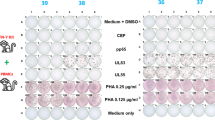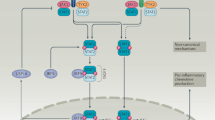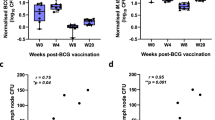Abstract
Interferons are being tested as antiviral and antitumour agents in man1–5, but because of their limited availability, clinical trials have remained inconclusive. Most of the interferon (IFN) preparations tested in man have been derived from human peripheral blood, buffy-coat leukocytes (HuIFN-α)6 induced by Sendai virus or from human diploid fibroblastoid cells (HuIFN-β) superinduced with poly(rI)-poly(rC)7. As production of interferon from leukocytes is restricted by the availability of blood donors, and production from cultured cells is a laborious and relatively costly process, the use of recombinant DNA technology may provide the most economical approach to the large-scale production of pure species of human interferon. The testing of such interferons is in its infancy. With the availability of bacterially produced HuIFN-α2 we have been able to compare its activity against vaccinia virus infection of the rhesus monkey with that of HuIFN-α from leukocyte buffy coats. Here we provide evidence that the two human α-interferons have comparable antiviral activity but that the bacterially produced form has fewer side effects, at least in the rhesus monkey.
This is a preview of subscription content, access via your institution
Access options
Subscribe to this journal
Receive 51 print issues and online access
$199.00 per year
only $3.90 per issue
Buy this article
- Purchase on Springer Link
- Instant access to full article PDF
Prices may be subject to local taxes which are calculated during checkout
Similar content being viewed by others
References
Stewart, W. E. II The Interferon System (Springer, New York, 1979).
Scott, G. M. & Tyrell, D. A. J. Br. med. J. 280, 1558–1562 (1980).
Krim, M. Blood 55, 875–884 (1980).
Sikora, K. Br. med. J. 281, 855–858 (1980).
Priestman, T. J. Lancet ii, 113–118 (1980).
Cantell, K. & Hirvonen, S. J. gen. Virol. 39, 541–543 (1978).
Billiau, A. et al. Antimicrob. Ag. Chemother. 16, 49–55 (1979).
Nagata, S. et al. Nature 284, 316–320 (1980).
Masucci, M. G. et al. Science 209, 1431–1435 (1980).
Goeddel, D. et al. Nature 287, 411–417 (1980).
Allen, G. & Fantes, K. H. Nature 287, 408–411 (1980).
Rubinstein, M. et al. Proc. natn. Acad. Sci. U.S.A. 76, 640–644 (1979).
Nagata, S., Brack C., Henco, K., Schamböck, A. & Weissmann, C. J. Interferon Res. 1, 333–336 (1981).
Streuli, M., Nagata, S. & Weissmann, C. Science 209, 1343–1347 (1980).
Mantei, N. et al. Gene 10, 1–10 (1980).
Weimar, W., Stitz, L., Billiau, A., Cantell, K. & Schellekens, H. J. gen. Virol. 48, 25–30 (1980).
Schellekens, H., Weimar, W., Cantell, K. & Stitz, L. Nature 278, 742 (1979).
Schellekens, H. & Weimar, W. thesis, Erasmus Univ., Rotterdam (1980).
Scott, G. M. et al. Br. med. J. 282, 1345–1348 (1981).
Author information
Authors and Affiliations
Rights and permissions
About this article
Cite this article
Schellekens, H., de Reus, A., Bolhuis, R. et al. Comparative antiviral efficiency of leukocyte and bacterially produced human α-interferon in rhesus monkeys. Nature 292, 775–776 (1981). https://doi.org/10.1038/292775a0
Received:
Accepted:
Issue Date:
DOI: https://doi.org/10.1038/292775a0
This article is cited by
-
The immunologic aspects of poxvirus oncolytic therapy
Cancer Immunology, Immunotherapy (2009)
-
Solubility as a Function of Protein Structure and Solvent Components
Nature Biotechnology (1990)
-
Preclinical safety testing of species-specific proteins produced with recombinant DNA-technqiues
Archives of Toxicology (1986)
-
Antiviral effects of bacteria-derived human leukocyte interferons against encephalomyocarditis virus infection of squirrel monkeys
Archives of Virology (1983)
-
Monkeys are insensitive to pyrogenic effects of human α-interferons
Nature (1982)
Comments
By submitting a comment you agree to abide by our Terms and Community Guidelines. If you find something abusive or that does not comply with our terms or guidelines please flag it as inappropriate.



